Mobile applications are all the rage for every business. Today, the first thing that comes to mind before launching a venture is to build a website and a mobile app, irrespective of what niche of the market you plan to enter.
Mobile apps are the new front in business for 2025. With Industry 4.0, their importance is greater than ever.
Apps have become the ultimate face of a brand, and hence, no business can survive without a proper application.
The mobile app market has experienced significant and continuous growth, with a global market size of $252.89 billion in 2023 and projections to reach $626.39 billion by 2030.
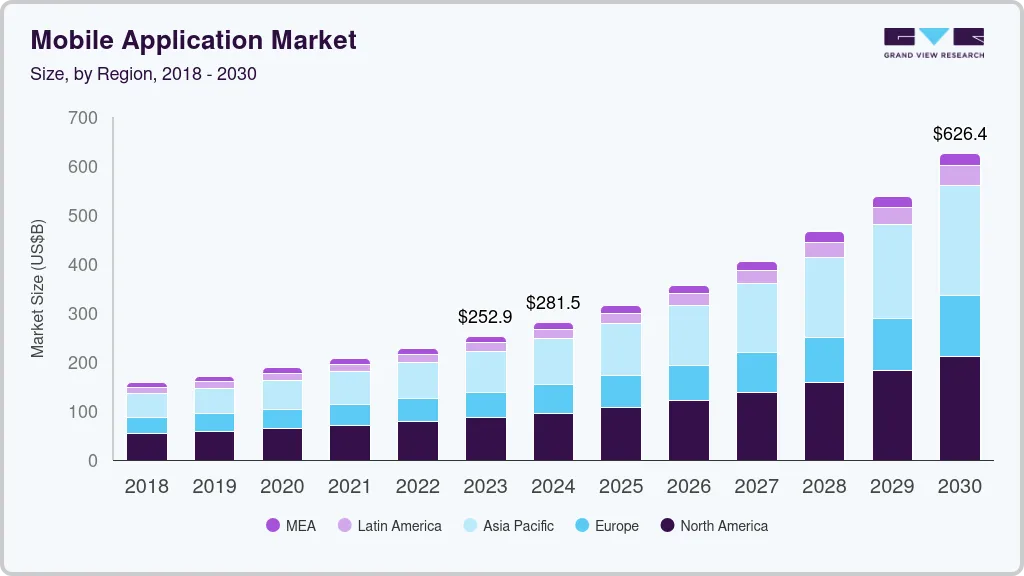
With several mobile app development companies available in the market, getting the job done has become easier.
However, the real question that arises here is how to develop a mobile application. Many people believe that hiring an app development company is enough to get the job done.
What they do not realize is that they should know exactly what they are looking for to get the best outcomes.
In this blog, let us take a look at all the necessary steps that are involved in the development of a mobile app, and things that you need to take seriously to be able to make the most of the available resources.
Without further ado, let’s get started!
How to Build a Mobile App? Development Lifecycle & Steps
Understanding the benefits of a mobile app for your business may have sparked your curiosity about the development process.
In this section, we’ll cover the steps involved in creating a mobile application from scratch. Hence, make sure you read this carefully.
There is a specific process to follow to create an optimized mobile application for your business.
Every step is like a piece of a jigsaw puzzle; the outcome is incomplete if even one of them is not placed correctly.
| Mobile App Development Lifecycle | |
| Stage of Cycle | Components |
| 1] Pre-Launch | Requirement Gathering |
| Planning & Design | |
| UI/UX Design | |
| 2] Frontend Development | User Interface Development |
| Frontend Logic | |
| Integration | |
| 3] Backend Development | Server-Side Development |
| Database Design | |
| Data Management | |
| 4] Post-Launch | Testing and Quality Assurance |
| Deployment | |
| App Store Approval | |
| Launch and Distribution | |
To justify the lifecycle of the development, there are 8 steps involved in developing the application-
Step 1: Ideation & Purpose Definition
When planning to build a mobile app of your own, it is important to understand two things:-
- What is it that you want to build?
- What is the purpose of building it?

The first step of developing an app is to answer these questions and understand the true sense of ideation and purpose definition. To break it down, here’s what is meant by the two terms –
-
Ideation
Sitting down with the experts and brainstorming to understand exactly what the scope of the app you build is called ideation. If you are a new business, this is what decides your company’s future. Hence, you should pay attention to the ideation.
-
Define Purpose
After identifying the idea, it is time to define the purpose of your app. For instance, if you are in any type of goods-selling business, would you want your app to directly sell, or simply drive more leads so you can connect and sell personally? This is how you define the purpose of your app.
After defining all the aspects of your idea and purpose, you have direction to start working. You can accordingly start exploring the same and researching the market.
Step 2: Research & Analysis
After you have understood the idea and purpose of your mobile application, it is time to find everything you can about the market you plan to enter.
Look for competitors and existing applications in the same niche. Identify all the factors, such as public reception, requirements, and existing gaps, to understand the market better.
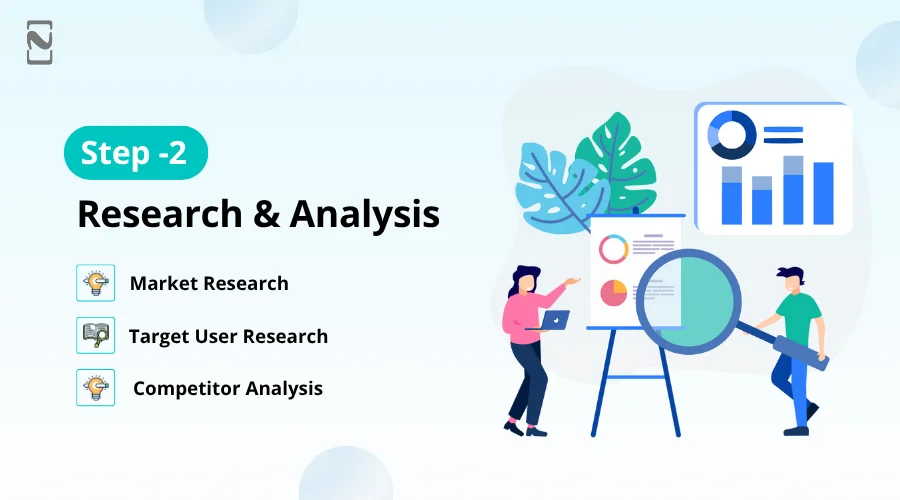
Generally, the research is carried out in three phases:
-
Phase 1: Market Research
Understanding the target market, user demographics, trends, and demand for similar apps.
-
Phase 2: Target User Research
Identifying the needs, preferences, and behaviors of the app’s target users.
-
Phase 3: Competitor Analysis
Analyzing the strengths and weaknesses of existing apps in the market to identify opportunities and differentiate your app.
Through all these phases, you get a solid mobile app idea for the market that you plan to enter.
Understanding the needs of the market is highly important before building a solution for the same, as when you have an app of your own, you become a part of the same market, and hence, you should know everything about the market, the targeted user, and competitor analysis.
Step 3: MVP App Development
Before going all in with the resources, you have the option of building a minimum viable product to understand the core of your application.
This product is a functional first version of the application that gives you a sneak peek into how your app will function.
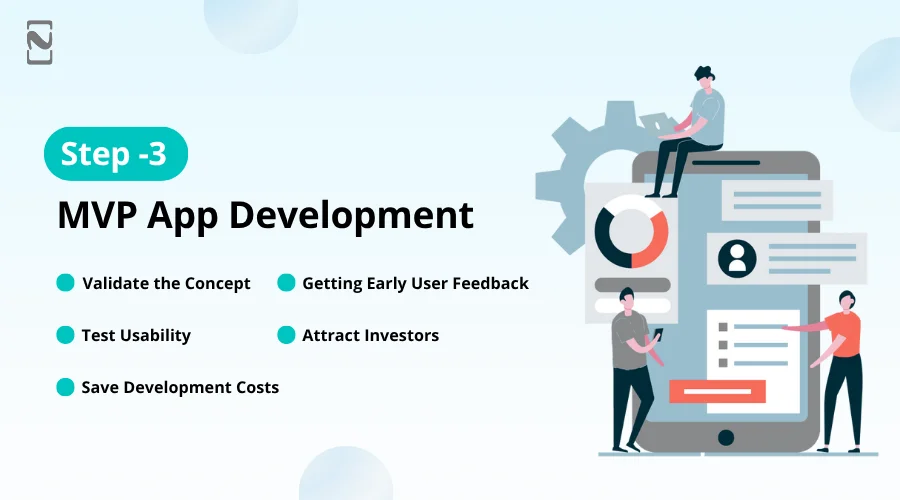
Not only does this give you a proof of concept, but it also helps you:
-
Validate the Concept
Build a basic version of the app with core features to test its viability and gather initial user feedback.
-
Test Usability
Conduct usability testing to ensure the app’s functionality, navigation, and user experience meet the target users’ expectations.
-
Save Development Costs
Focus on essential features and gradually expand based on user feedback and market response.
-
Getting Early User Feedback
Collect feedback from users to improve the app’s functionality and user experience.
-
Attract Investors
Demonstrate the potential of the app and its market acceptance to attract potential investors.
The clarity of what you have started gives you enough motivation to finish the project and go for a full-fledged application.
Not to mention, if the MVP does not fulfill your expectations, you can go back to the drawing board and start building the app again.
Step 4: Define Development Tools
If you are fine with the MVP, or it gets you the required confidence, start building a plan and choose the tools you will require. Identifying the platform that you want to choose to execute your app idea can further help in simplifying your selection of tech stack and other necessary decisions.
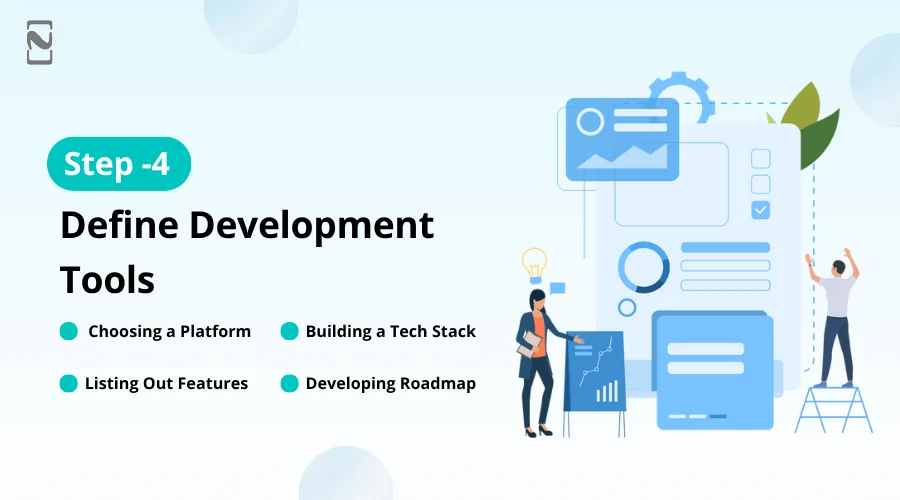
Here’s everything this step will help you with –
-
Choosing a Platform
Selecting the platform(s) on which the app will be developed based on the target audience and market considerations. Here you have the following options:
- Android
- iOS
- PWA
-
Building a Tech Stack
Identify the top frameworks and required tech stack to develop the app, considering factors like scalability, performance, and development expertise.
-
Listing Out Features
Creating a comprehensive list of features and functionalities that the app will offer to meet user needs and stand out from competitors.
-
Roadmap Development
Creating a roadmap with timelines, milestones, and task allocation to ensure a smooth development process.
After you have chosen each of these development tools, it is time to start with the development and design stages. Keep in mind that this step is your chance to choose the most appropriate tech and approach to finish the app development properly.
Step 5: UI/UX Design App
So now that you have all the necessary tools, insights, and architecture design plan ready, it is time to start designing the application.
Designing an appealing and user-friendly interface is crucial for the app’s success. Now, UI/UX design can be divided into different components.
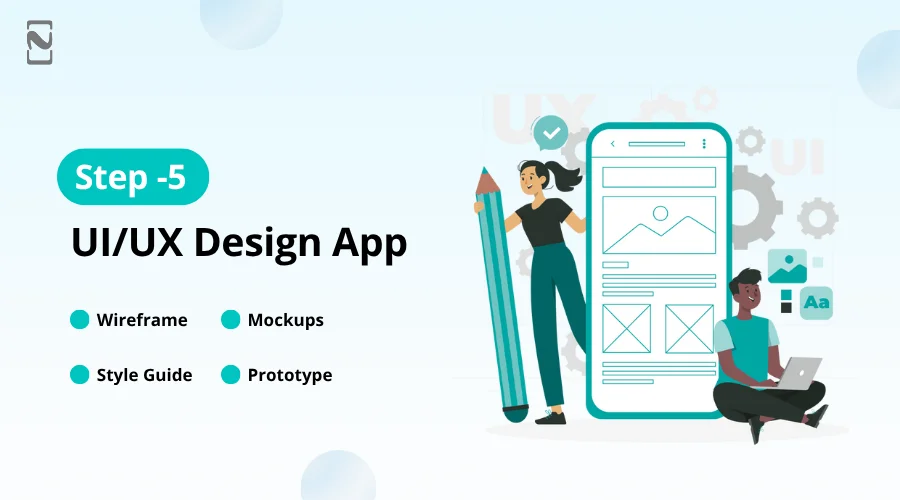
They are:
-
Wireframe
Creating a basic visual representation of the app’s layout and structure, outlining the placement of key elements and user flow.
-
Style Guide
Defining the app’s visual style, including color schemes, typography, and graphical elements, to maintain consistency throughout the app.
-
Mockups
Developing high-fidelity visual representations of the app’s screens, showcasing the UI design and interactivity.
-
Prototype
Building an interactive, functional prototype to simulate the app’s user experience and gather feedback before development.
All these components can help you get a well-designed application that has an intuitive UI/UX with easy-to-develop functionalities. With the correct wireframe, you will have a dedicated solution on how to develop the app and can follow the same for a perfect product.
Step 6: App Development Process
Well, this is part of the app development process where mobile app developers put the most effort in.
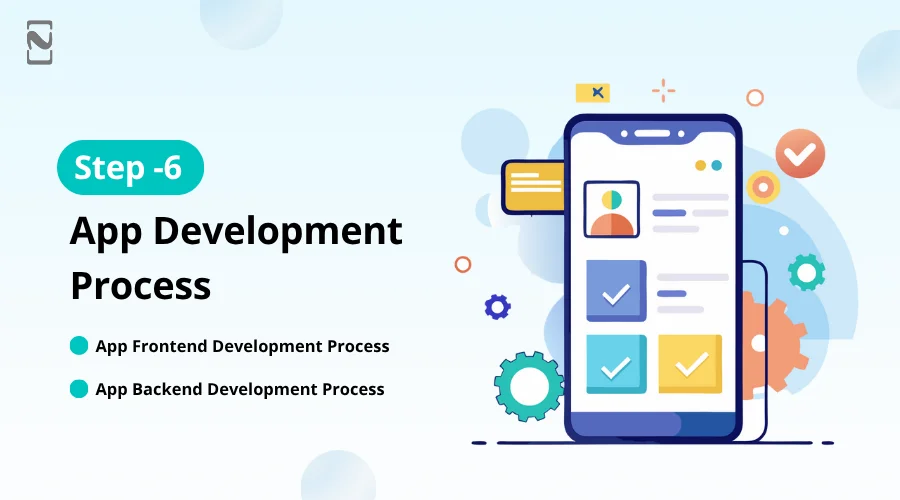
App development can be divided into two different steps, as mentioned below:
-
App Frontend Development Process
Building the user interface of the app using front-end technologies like HTML, CSS, and JavaScript, focusing on responsiveness and visual appeal.
-
App Backend Development Process
Developing the server-side logic, APIs, and database management to handle data processing, storage, and interaction with the app’s front end.
This is the most time-consuming stage of the application development process. Based on the complexities in each of your app’s frontend and backend development, this step is carried out, and accordingly, the app is developed.
Step 7: Testing
Developing the finished product is still a few steps away, even after you have developed all the functionalities. That is why testing the application is crucial.
Mobile app testing is a critical phase of the app development process to ensure the app’s quality and functionality.
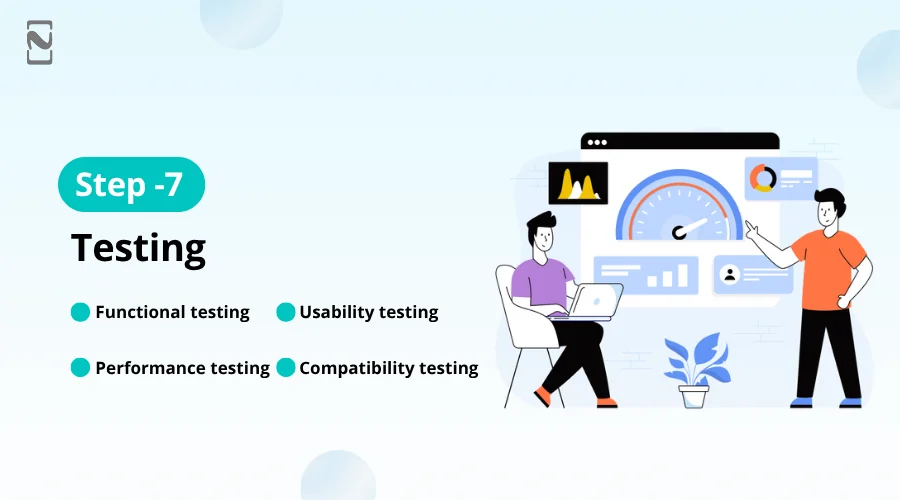
This involves conducting various testing methods:
- Functional testing
- Usability testing
- Performance testing
- Compatibility testing and more.
The purpose of testing an application is to ensure all functionalities work as intended. If something isn’t functioning properly, you can still return it to development since it hasn’t been deployed yet.
Step 8: Deployment
If everything goes well in the testing stage, your application is ready for deployment. The whole point of deploying an application is to make the app available to users. So, what do we do here?
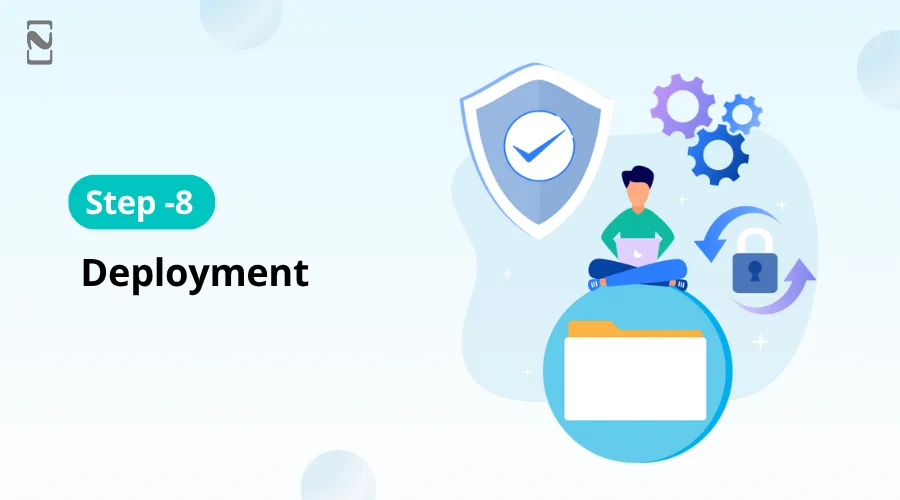
Well, here are some things we need to do here:
- Preparing the app for distribution, following the guidelines and requirements of app stores (e.g., Apple App Store, Google Play Store).
- Submitting the app for review and approval.
- Setting up the necessary backend infrastructure and configuring servers.
After the app is deployed, what’s left is ongoing maintenance. Monitoring the app’s performance, analyzing user feedback, and addressing bug fixes and issues promptly.
The team also regularly updates the mobile app’s security, functionality, and user experience to improve. In addition to this, they also ensure compatibility with new OS versions and device updates.
This pretty much sums up the entire app development process. All the steps mentioned hold a significant role in the app.
Sure, the entire process comes with an app development cost attached to it; however, with proper optimization and choosing the right team, you can easily make the most out of this process and build an app for your business.
Best Practices for the App Development Process
While the development process seems simple, it is not that easy to execute. You need professional mobile app developers and an understanding of the entire process to move forward.
However, it is in no way impossible to take your first step towards app development.
There are a few practices that can help you overcome all these issues and improve your chances of success in building your first app.
If you are someone new and looking to ease your way into the development process.
Here are some best practices that might help:
- Make sure your research is thorough and fruitful.
- Focus on simplifying existing solutions by creating a better user experience.
- Make sure you make the correct choice in SDLC Vs Agile development approach, as that defines the course of action.
- Choose a cross-platform language so that one code runs on all the platforms.
- Ensure your backend is scalable to upgrade in the long run.
- While writing code, make sure the environment is safe and free of any errors/security flaws.
- Test your code multiple times to ensure no issues arise during the execution of the functionality.
- Make sure the app you build is compliant with all the regulations and compliances.
- Keep in mind that your job does not end with the completion of development; monitor app performance and reflect on the feedback that you receive.
- Work on optimizing app performance for better speed and performance.
- Continuous Integration and Deployment (CI/CD) automate integration, testing, and deployment processes.
- Plan for regular bug fixes, feature updates, and compatibility maintenance.
- Curate all the app store and Play Store details properly for better visibility.
Ideally, you can make the most of the app development process by hiring a team of professional developers and analysts.
There are several development companies available in the market. If you are looking for a way to build apps faster and under a certain budget, you can easily reach out to Nimble AppGenie.
Why Invest in Mobile App Development? Benefits for Businesses
You see, there was a time when every company had to build and develop a brick-and-mortar store, or an outlet to offer their services. This is the definition of a brand’s presence in the market.
The more stores or physically available the brands were, the more people knew about them.
However, today, you need not worry about investing on multiple fronts to be seen; a single mobile application can serve as a global outlet and reach every customer sitting across the globe. But that is only one of the benefits that mobile app development brings to a business.
Several other benefits motivate a business to invest in developing a mobile app.
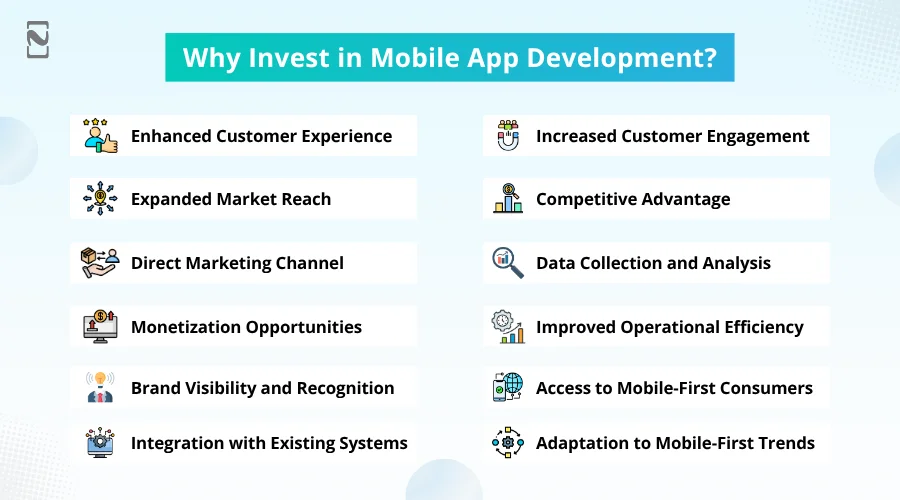
What are those, you wonder? Let’s find out!
-
Enhanced Customer Experience
Mobile apps provide a personalized and convenient experience for customers, allowing them to access products, services, and information on the go.
-
Increased Customer Engagement
Apps enable businesses to engage with customers through push notifications, personalized offers, and loyalty programs, fostering brand loyalty and customer retention.
-
Expanded Market Reach
Mobile apps open up new avenues for businesses to reach a broader audience, including users who prefer mobile devices over traditional platforms like desktops or laptops.
-
Competitive Advantage
Having a well-designed and functional app can differentiate a business from its competitors and position it as innovative and customer-centric in the market.
-
Direct Marketing Channel
Apps provide a direct and targeted marketing channel, enabling businesses to send promotional messages, offers, and updates directly to users’ devices.
-
Data Collection and Analysis
Mobile apps enable businesses to collect valuable user data, including demographics and preferences, which can be analyzed for strategic insights.
-
Monetization Opportunities
Powered by monetization strategies, apps can serve as revenue generators through in-app purchases, subscriptions, advertisements, or by driving traffic to other revenue-generating channels, such as e-commerce websites.
-
Improved Operational Efficiency
Mobile apps can streamline internal processes, such as inventory management, order processing, and customer support, leading to improved operational efficiency and cost savings.
-
Brand Visibility and Recognition
A well-designed app with a visually appealing interface can enhance brand visibility, increase brand recognition, and leave a lasting impression on users.
-
Access Mobile-First Consumers
With the increasing number of mobile device users, businesses can tap into the growing population of mobile-first consumers by offering a seamless mobile app experience.
-
Integration with Existing Systems
Mobile apps can integrate with existing business systems, such as CRM or ERP software, enabling seamless data synchronization and enhancing overall business productivity..
-
Adapting to Mobile-First Trends
Investing in mobile app development aligns businesses with the increasing mobile-first trends, ensuring they stay relevant and accessible in a fast-evolving digital landscape.
All in all, leveraging mobile app development to boost your business is highly profitable, as it requires less investment and can generate better value. The whole concept of launching your application allows you to be closer to
your customers and simplifies the customer journey in using your services/buying your product.
Conclusion
Mobile app development is a growing trend where more and more businesses are inclined towards building a mobile app of their own.
However, you cannot find anything until you know exactly what you are looking for. Choosing a mobile app development company is not easy if you are not aware of the process, and hence, you need to understand every integral detail about the same.
Hopefully, with this blog, you might have gained enough insights on how mobile app development works and what the ultimate process is that you should follow, or the developers follow to gain the best results.
That will be all for this post. Thanks for reading, good luck!
FAQs
The app development process refers to the step-by-step procedure followed to create a mobile application, including planning, design, development, testing, and deployment.
The time required to develop an app varies based on the complexity, features, and resources available. On average, it can take anywhere from a few weeks to several months to complete.
Key stages include ideation and planning, wireframing and design, development, testing, deployment, and ongoing maintenance and updates.
To improve app security, implement secure coding practices, encrypt data, ensure secure authentication, conduct regular security audits, and perform timely updates.
Agile development is an iterative and flexible approach that emphasizes collaboration, adaptability, and quick releases. It enables developers to respond to changing requirements and deliver high-quality apps efficiently.
App development costs vary depending on factors like complexity, features, platform, and development team rates. It is advisable to get a detailed quote from potential developers.
Yes, you can modify or add features to your app post-launch. It’s common to release updates based on user feedback, market demands, and your business objectives. Continuous improvement is key to app success.
Wireframing and prototyping help visualize the app’s structure, layout, and user flow before actual development begins, allowing for early feedback and adjustments.

Niketan Sharma, CTO, Nimble AppGenie, is a tech enthusiast with more than a decade of experience in delivering high-value solutions that allow a brand to penetrate the market easily. With a strong hold on mobile app development, he is actively working to help businesses identify the potential of digital transformation by sharing insightful statistics, guides & blogs.
Table of Contents






No Comments
Comments are closed.